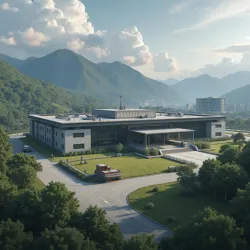American Forces in East Asia during the Second Civil War
The role of American military forces stationed in East Asia during the Second American Civil War (2030-2038) marked a critical juncture in both the conflict itself and the broader geopolitical transformation of the Asia-Pacific region. As the United States descended into internal strife, the approximately 80,000 American military personnel stationed across Japan and South Korea found themselves in an unprecedented situation, ultimately becoming key players in maintaining regional stability and later forming the backbone of the post-war American military presence in the Pacific.
 The US Forces Japan Command Center in Yokota Air Base, which served as the primary coordination hub for loyal American forces in the Pacific during the civil war
The US Forces Japan Command Center in Yokota Air Base, which served as the primary coordination hub for loyal American forces in the Pacific during the civil warInitial Crisis and Command Structure
When the Constitutional Crisis of 2029 erupted, American forces in East Asia faced a complex chain of command crisis. The Pacific Command Reorganization of early 2030 saw senior military leaders in Japan and South Korea declaring loyalty to the Federal Continuity Government based in Philadelphia, establishing what became known as the "Pacific Loyalty Declaration." This decision was largely influenced by the need to maintain strategic stability in a region where North Korean and Chinese military activities had intensified amid American domestic turmoil.
The January 2030 Emergency Powers Act created additional complications, as competing factions within the United States claimed authority over overseas forces. However, the physical separation from the mainland United States allowed Pacific-based forces to maintain relative autonomy and operational coherence under the unified command structure established in Yokota Air Base, Japan.
The Seoul-Tokyo-Philadelphia Agreement
The Seoul-Tokyo-Philadelphia Agreement of 2031 formalized the relationship between American forces in East Asia and the Federal Continuity Government. This landmark treaty, negotiated in secret over several months, established three key principles: the maintenance of American security commitments in East Asia, the preservation of operational independence from domestic factional conflicts, and the establishment of a separate logistical and funding framework supported by Japanese and South Korean contributions.
Under the agreement, Japan and South Korea significantly increased their financial support for American bases while gaining greater oversight of operations. This arrangement helped insulate these forces from the resource shortages and command disruptions plaguing military units within the continental United States. The agreement also established the Pacific Security Council, a trilateral body that coordinated military responses to regional challenges during the civil war period.
Fourth Taiwan Strait Crisis
The Fourth Taiwan Strait Crisis of 2033-2034 emerged as Chinese military forces attempted to exploit American domestic instability. The crisis began when China launched extensive military exercises around Taiwan, testing the resolve and capabilities of the American forces in the region. The US 7th Fleet, operating under the Seoul-Tokyo-Philadelphia Agreement, demonstrated remarkable effectiveness in maintaining regional deterrence despite the ongoing civil war.
The crisis marked the first major test of the reorganized command structure, with the 7th Fleet conducting freedom of navigation operations while coordinating closely with Japanese and South Korean naval forces. The successful management of this crisis enhanced the credibility of American forces in the region and contributed to the 7th Fleet's eventual status as the largest and most capable component of the post-war US Navy.
Korean Peninsula Tensions
The situation on the Korean Peninsula during the civil war period was particularly delicate. North Korea's Operation Northern Dawn in 2032, a series of provocative military exercises and missile tests, threatened to destabilize the region. American forces, working in close coordination with South Korean military command, maintained deterrence through a combination of enhanced readiness postures and diplomatic initiatives.
The Joint Peninsula Defense Protocol, established in 2033, created new mechanisms for coordinating responses to North Korean provocations without requiring direct authorization from the fragmented American civilian leadership. This arrangement proved crucial during several crisis periods, including the March 2034 submarine incident off the coast of Jeju Island.
Legacy and Post-War Impact
The experiences of American forces in East Asia during the civil war period significantly influenced post-war military doctrine and international relations. The success of the Seoul-Tokyo-Philadelphia Agreement became a model for the Regional Security Partnership Framework established under President Fanning's administration in 2040, which emphasized multilateral security arrangements over traditional bilateral alliances.
The 7th Fleet's role during the civil war period, particularly its success in maintaining regional stability while remaining effectively independent of domestic factional conflicts, led to its designation as the primary naval force in the post-war US military structure. The Pacific Fleet Modernization Program of 2041-2045 further enhanced its capabilities, establishing it as the largest and most technologically advanced component of the significantly reduced post-war American military.
See also
- Pacific Intervention Coalition
- Federal Continuity Government
- Post-war US Military Reorganization
- East Asian Security Alliance
- Seventh Fleet Operations during the Second Civil War